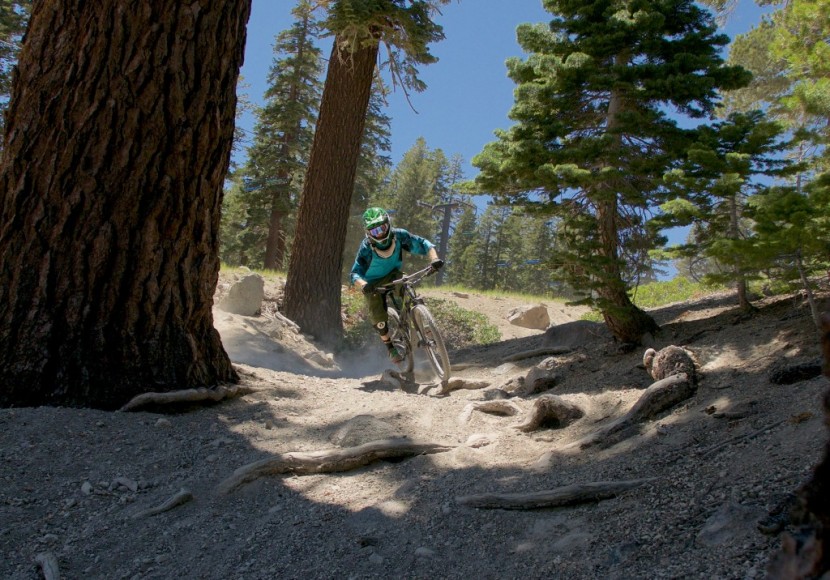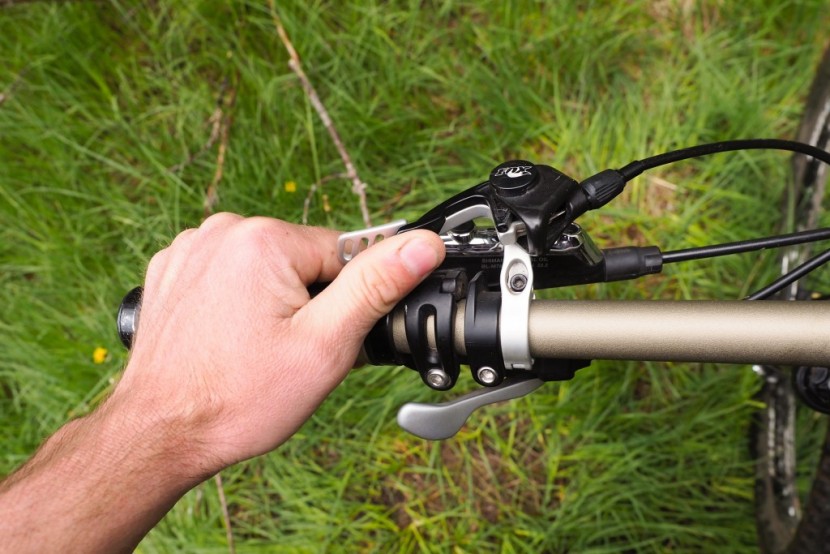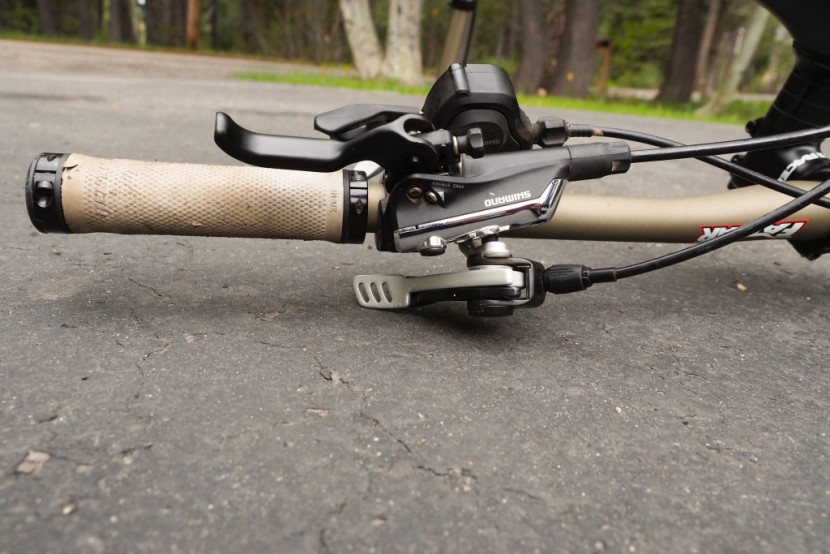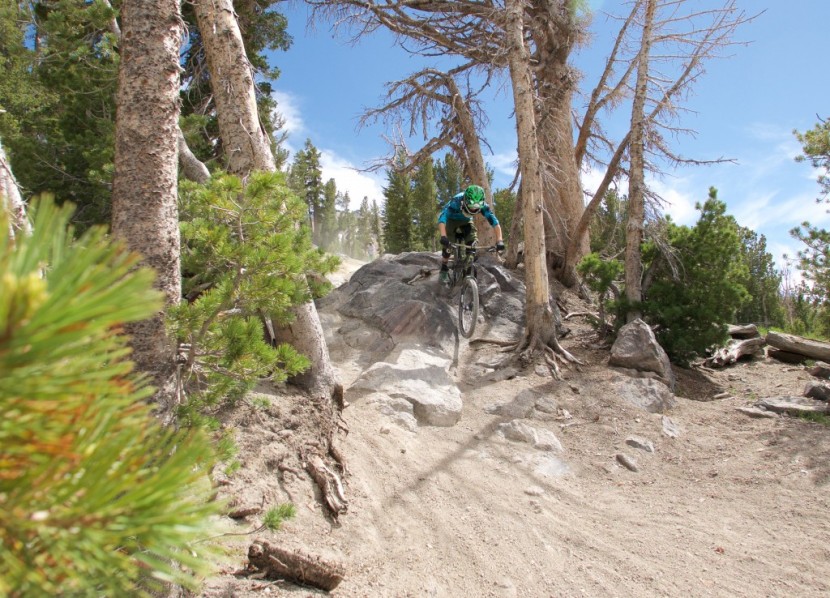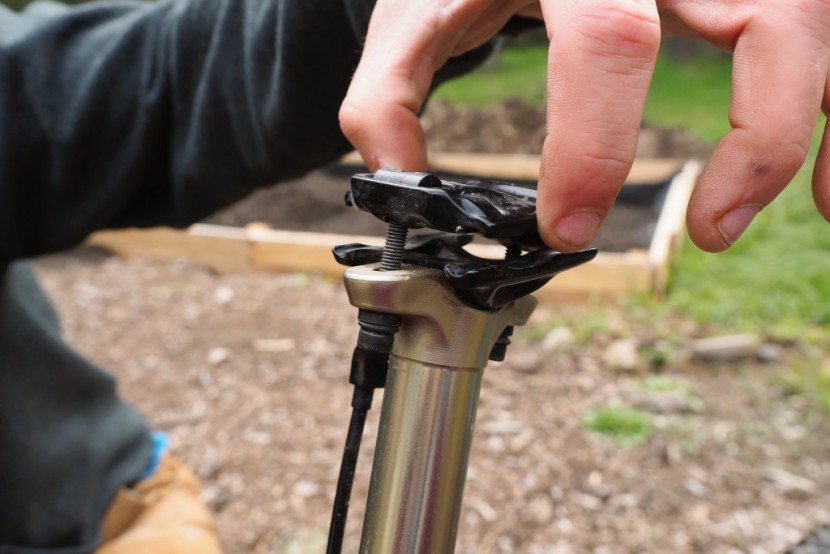The Fox D.O.S.S. is a three-position post within Fox's CTD Ride Dynamics System; the CTD refers to the three positions; climb, trail, and descend in which riders access each position using a unique dual lever remote. The post can be ridden at full height, 40mm drop, and fully dropped. A shorter black paddle on the remote grants access only to the middle 40mm drop position, removing any guesswork regarding saddle height beneath the rider. Although unique and innovative, the remote is rather bulky. When mounted atop the bars while using a front derailleur, the bulkiness is exacerbated and the remote becomes very difficult to use when navigating technical, unfamiliar terrain. For comparison, finding the middle position typically wasn't a very difficult job on the other multi-position dropper, the Specialized Command Post IRCC, and no second lever is incorporated onto their remote.
The D.O.S.S has a snappy return speed and the external cable routing allows this dropper to be mounted to a greater variety of bikes. Setup is pretty straightforward: the saddle clamp holds tight, and you'll never get left in the woods with a dropped seatpost, 20 miles between you and your front door. If the cable is damaged or snagged rendering the post unmovable, it can be manually actuated.Fox D.O.S.S Review
Our Verdict
Our Analysis and Test Results
Hands-On Review
The Fox D.O.S.S has a lot going for it. Precision mechanical internals provide a crisp, snappy saddle return, while external cable routing makes this a very versatile post, especially for consumers seeking an aftermarket dropper post on a late model bike frame. The post can be actuated by hand in the event a branch grabs the cable and pulls it out midway into a long ride, meaning you'll never get stuck with a quad-crushing pedal home with a dropped seat. Unfortunately, we could not get past the bulky remote design with funky ergonomics that we felt really prevented this dropper from winning our hearts. If you're still running a front derailleur, definitely look elsewhere.
Remote
The D.O.S.S. features a unique dual-lever remote; the longer silver lever is used to fully drop the post or to re-extend it to full 125mm height. You can stop at the middle “trail” position using this lever as well; the shorter black lever only drops to the 40mm “trail” height. We view the remote's design as the biggest detriment to this dropper seatpost, especially when mounted on top of the handlebars. When running a front derailleur, this will invariably be the position in which the lever mounts. Our primary concern was that riders are forced to move their thumb above the bar to push the lever inwards. This hand position makes the rider more vulnerable to losing their grip on the bar when accessing the remote, especially when riding rough or unfamiliar terrain. On test rides, many testers admitted that they were reluctant, or eschewed altering their saddle height altogether, when terrain became excessively challenging. Unfortunately, this forced them into less-than-ideal riding positions.
Reaching for the lever when mounted atop the bars felt awkward and unnatural, with the level feeling far away and at an odd angle. Despite three different mounting holes, we could not find a configuration that remedied this complaint. These holes allow fore and aft adjustment, but rotating the remote along a y-axis is not possible. The shorter black lever sits further inboard and becomes even more of a stretch to reach.
The remote also requires a greater effort to actuate as a result of the awkward ergonomic position; it sits high above all other componentry, resting on the ground during trailside repairs (when the bike is commonly flipped upside down), such as when changing a flat tire. The undue amount of weight put through the remote on these occasions make it more susceptible to damage. Cosmetic damage, like scratching, is virtually unavoidable unless you ride exclusively on golf course greens (this behavior is not condoned by OutdoorGearLab).
Conversely, a majority of these perceived shortcomings are remedied by mounting the remote below the handlebars; again, this is only an option for those running a 1x drivetrain. In this position, the remote feels much more intuitive, boosting confidence when changing saddle height in demanding terrain. The rider is also able to maintain a safer, more complete thumb wrap on the handlebars while actuating the seatpost. The remote is also far less prone to damage when tucked under the handlebar.
No other post presented with such split personalities. Whether or not your bike has a front derailleur should play a pivotal role in deciding upon this dropper seatpost.
Smoothness
Crisp might be a better descriptive term for the action of the D.O.S.S. The seat audibly returns to the topped-out “climb” setting and the noise leaves no question regarding saddle position unless you're the type that rides with headphones blaring. In which case, you might not hear the roaring mountain lion named Darwin behind you.
One of our testers, a shop mechanic, explained Fox's unique use of ball bearings that roll along machined grooves corresponding to the CDT (climb, trail, descend) settings. To keep the stanchion from rotating, Fox employs the use of self-adjusting keys that lock into machined grooves within the inner post. These keys help keep the whole assembly tight and prevent the annoying side-to-side movement that can be detected by wiggling the nose of the saddle of other posts. The system is self-adjusting so that as wear occurs in either the keys or their corresponding grooves, they still mate as closely as when the post was new. Admittedly, we were fans of a mechanical system that accounts for wear and believe this must contribute largely to reports of long-term reliability with this post.
There is very little noticeable resistance as the post cycles through its settings. We suspect this is due in large part to the previously mentioned ball bearings. The return speed is fast and undampened, similar in speed and quality to the Specialized Command Post. It stands in stark contrast to the return quality of the Thomson Elite Covert, the Editors' Choice award winner, which features a much softer, dampened 15 mm of top-end return. Throughout our test, riders tended to quickly accommodate to both types of saddle return, slow and fast; they were mostly split on preference.
Testers were not so evenly split on their feelings about infinite height adjustment and multi-stage dropper posts. As we saw with the other multiple position dropper, not every rider found the set positions ideal for the terrain. For example, the terrain found near our office in South Lake Tahoe, CA can be quite technical. The middle 40 mm “trail” position felt too high for some when trending downhill over loose rocky terrain that didn't necessarily require the full “drop” position. Unlike an infinitely adjustable post, the inability to drop the saddle just a little on techy climbs, where we might put a foot down, is also a bummer. This example illustrates one main difference that warrants careful consideration when deciding which type of dropper post is best for you. Refer to our buying advice article for more information. When things don't go so smoothly out on the trail and a rogue tree branch snags the actuator cable, the post can be manually actuated.
Saddle Clamp
The saddle clamp is remarkable, if only because it isn't super annoying to put the seat on or take it off. It held position during slams to the back of the saddle when putting down the landing gear on drops and the end of the actuation cable can be neatly tucked into a gap on the lower saddle clamp. We discovered this neat little trick after cutting our cable and trying to twist it out of the way in a more unsightly manner. The upper saddle clamp holds the cable neatly inside. Rounded washers and a deep head allen bolt make installation a breeze. The cylindrical nuts that recess into the upper saddle clamp are easy to hold in place and stop from spinning when threading the bolts from below. Despite an overall similar design to many other saddle clamps we tested, this model proved exceptionally easy to work with.
Ease of Setup
This post's external cable routing is much simpler than the other internally routed posts we reviewed; the DIY home mechanic will have a much easier time not having to fish the cable through their frame. Even well practiced shop mechanics that have all the tools and know all the tricks still have a certain disdain for internal cable routing. The cable mounts on the side below the seat clamp and allows for smooth routing. Additionally, the saddle clamp bolts are not obstructed by the actuation cable making saddle installation and removal an easy process.
Cable length is easy to determine given that nothing is hidden within the frame. Simply run the cable along the frame, pull it taut, and tighten the 2.5mm allen screw at the post's head. The final crimped end tucks neatly into the lower saddle clamp to tidy things up. Cable tension occurs at the remote and if you don't completely nail tension on the setup, rotating the barrel adjuster is likely all that will be required. Too little tension would result in the post getting hung up on the middle trail position, while excessive tension can result in “phantom” movement. Clockwise rotation of the barrel adjuster to loosen tension solved the problem.
Weight
The D.O.S.S. was the heaviest dropper we tested by a good margin. At 683 grams, it was 51 grams heavier than the second heaviest Specialized which weighed 632 grams. The clunky remote surely adds weight to the unit, though The Fox is also fully mechanical, lending to a heavier construction.
Best Applications
This is a very appealing post to the rider looking to finally take the plunge and upgrade their rig with a dropper post. Hopefully you were faster to adopt the 1x drivetrain because the remote functions much better when mounted under the bars. If you've waited this long, chances are the bike you're slapping this on doesn't feature internal cable routing. No worries here. The easy setup and reliable performance of this post will have you out on the trail in no time.
Value
This post has become increasingly difficult to find from online retailers. When it debuted, it retailed for $439. More recently, numbers dropped to around $340. If you're having a hard time stomaching the cost of most droppers, here's a good place to start. $299 seems more prevalent these days, especially if the bike you're putting this dropper on is a few years older; at this price, the upgrade makes a bit more sense. We suspect screaming online deals to come soon with the release of the new Fox Transfer dropper post.
Conclusion
This is a three position dropper post with a lightning fast return rate that has proven reliable over time. If you can mount it below your handlebars, you might think this is the best thing since the advent of the suspension fork. When mounted above the bars, the chunky remote severely detracts from the performance and aesthetics of this post. The ability to manually cycle the post, should you obliterate the lever in a crash, ensures you'll never be stuck 20 miles from home with a permanently dropped seat.



